Archive for the 'Freeware' Category
Thursday, March 22nd, 2007
 RocketDock is a Mac-inspired dock for Windows users. For those that don’t know, a dock is fancy toolbar with some effects and added functionality thrown in and is a standard feature on Mac computers. It comes from the same people who made UberIcon, which i recently reviewed and if you also use that, Rocketdock also includes a function to use the same effects as you have chosen in UberIcon. RocketDock is a Mac-inspired dock for Windows users. For those that don’t know, a dock is fancy toolbar with some effects and added functionality thrown in and is a standard feature on Mac computers. It comes from the same people who made UberIcon, which i recently reviewed and if you also use that, Rocketdock also includes a function to use the same effects as you have chosen in UberIcon.
Some of its features include the ability to minimize windows to the dock and real-time window previews in Vista, ObjectDock Docklet support,compatible with MobyDock, ObjectDock, RK Launcher, and Y’z Dock skins, you can use icon sets you find online, and apparently it runs great on slower computers too!
Check the site for the full list of features.
Maybe you are a Mac user and want to have similar functionality on your Windows machine, or even if you just want to liven up your Windows desktop a little, it’s worth checking out this very smooth and very customizable and also very free program. Click here for more info and to download it.
Posted in Design, Developer, Freeware, Information Management, Internet, Mac Stuff, Main, Shell and Desktop, Utilities | 6 Comments »
Thursday, March 22nd, 2007
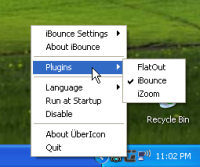 This is a cool little program that adds cool effects when you click on icons in your PC such as folder or program icons. This is a cool little program that adds cool effects when you click on icons in your PC such as folder or program icons.
It has plugin-based effects, so users can create their own effects and it includes 3 pretty cool looking ones as default. Some extra ones can be download from here. You choose which particular effect you want to use by right clicking on the tray icon and clicking “Plugins”.
This program has apparently been made just for fun, so depending on your point of view, you will either think its a cool addition to customizing your computer, or just another thing that doesn’t do much.
Whatever your opinion, it’s free, so to see it in action, go try it out as its easier to see working than it is to try and describe it click here for more info and to download it.
Posted in Design, Developer, Freeware, Fun, Main, Shell and Desktop, Windows | No Comments »
Thursday, March 22nd, 2007
 Face it, who really reads the EULA’s ( End User License Agreement) in software they install? Most of us just scroll ahead and click “Accept”. But it’s something we all should do because if we don’t, we can eventually wind up with all kinds of spyware on our computers that could lead to serious problems.This program analyses the EULA and picks out suspicious text in it, letting you know if there’s anything you don’t want to agree to, such as installing adware or transmitting personally identifiable information etc. Face it, who really reads the EULA’s ( End User License Agreement) in software they install? Most of us just scroll ahead and click “Accept”. But it’s something we all should do because if we don’t, we can eventually wind up with all kinds of spyware on our computers that could lead to serious problems.This program analyses the EULA and picks out suspicious text in it, letting you know if there’s anything you don’t want to agree to, such as installing adware or transmitting personally identifiable information etc.
A useful tool for anyone who cares about their privacy and doesn’t fancy going to law school in order to figure out what the five minutes of reading an EULA just meant!
Its free, get it here.
Posted in Business, Commercial, Developer, Freeware, Games, Information Management, Main, Security, Shareware, Utilities, Windows | No Comments »
Wednesday, March 21st, 2007
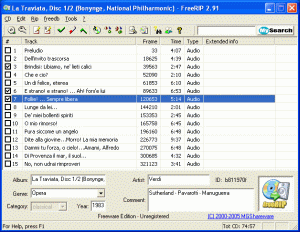 Here is a freeware that can help you get your digital audio tracks recorded quite easily. Here is a freeware that can help you get your digital audio tracks recorded quite easily.
FreeRIP MP3 can record digital audio tracks directly from compact discs, without going through your sound card. You can save tracks as CD-quality WAV files or encode them to Ogg Vorbis or MP3 compressed format.
With FreeRIP, you can convert audio files from one format to another; WMA and Wav files to MP3 or Ogg Vorbis, and vice versa. One very useful feature that comes with this software is the music search bar which helps you search for MP3 and music files on the Internet, or search for CDs in Amazon.com CD catalogue.
Want something in your own language? well this might just be the thing for you, FreeMp3 offers multilingual support as it supports 25 languages.
Though FreeRIP MP3 is supposed to be freeware; the publisher welcomes your support through registration. The truth is registering this program will suppress the splash screen at startup.
Want To See If This Is For You?
Try It Out HERE!
Posted in Audio, Developer, Freeware, Fun, Main, Multimedia, Music, Windows | No Comments »
Tuesday, March 20th, 2007
TrueCrypt is an amazing free disk encryption program.
 There are a couple of different ways in which you can use TrueCrypt. First, you can encrypt an entire partition on your drive (but not an existing partition). Or, you can create a file on your system that will act as a virtual partition. I like to do the latter because it allows me to backup the partition to DVD or even carry it around with me by putting it on a USB drive, like my iPod. This is handy if you like to carry sensitive information with you wherever you go. There are a couple of different ways in which you can use TrueCrypt. First, you can encrypt an entire partition on your drive (but not an existing partition). Or, you can create a file on your system that will act as a virtual partition. I like to do the latter because it allows me to backup the partition to DVD or even carry it around with me by putting it on a USB drive, like my iPod. This is handy if you like to carry sensitive information with you wherever you go.
The following main features are some of what make TrueCrypt simply the best disk encryption software around:
- TrueCrypt partitions look and work just like any other drive. Once you mount a TrueCrypt volume–by entering the volume’s password–it gets assigned a drive letter. So you can deal with the files just as you would if it were a secondary hard drive (copy, paste, delete, etc.)
- TrueCrypt is both free of charge and it’s open-source; which means you can trust it to do what it claims.
- TrueCrypt doesn’t use the Windows registry. Instead, it uses an XML file. This makes it portable and version compatible. Not only can you use TrueCrypt on XP, 2000, Windows Server 2003 and Vista, but you can use it on Linux and OS X (and it will probably be ported to even more operating systems than that.)
- TrueCrypt volumes can exist on CD’s, DVD’s, USB drives and so on (as long as you make sure to use UDF or FAT32 file systems).
- TrueCrypt affords you plausible deniability. What this means is that if, for whatever reason, some adversary tries to get at your files, they not only wouldn’t be able to hack your encryption. They wouldn’t even know that you encrypted anything in the first place! There’s simply no way to prove you’re using encryption. TrueCrypt makes your encrypted volumes undetectable as being encrypted. Instead, they just look like some random garbage file. Also, TrueCrypt allows for nested encrypted volumes. This means you could throw some junk files in the first layer–then tell someone the password for that–and they would only see that junk and assume you cooperated with them, since you gave them your password. However, the real data that you wanted encrypted would actually be contained within that as a second layer, invisible to the adversary.
Of course, to really convince them, those “junk” files should look like something worthy of being encrypted or they might assume you’re trying to trick them.
- TrueCrypt is superior to Windows XP’s built-in hard drive encryption because it’s open-source, portable across multiple Operating Systems and comes with plausible deniability. XP’s encryption doesn’t have plausible deniability because it uses certificates that anyone can view from the windows directory–which means they can know that you’re hiding something.
- TrueCrypt lets you choose from of the best algorithms in existence and you can even layer multiple algorithms on top of eachother for added security; though doing so is really overkill. Unless you really know what you’re doing, just use the default AES encryption. Furthermore, TrueCrypt doesn’t even know which algorithm you’re using. It tries your password against them all, until one works. This feature is needed for plausible deniability.
There are some other things to note: Currently, when you install TrueCrypt it will come with pretty good documentation in PDF form, so don’t worry about finding documentation online. Also, if you lose your password/key you won’t ever be able to access your TrueCrypt volume(s)! There’s no way you can hack your password back; this is truly strong security. So make sure you don’t lose your password. An additional precaution you can take is to back up the header file that TrueCrypt uses. What this allows you to do is change your password and the original key will still work as the master key.
So, I hope I’ve sold you on this program. Many–if not all–of the top security gurus out there use TrueCrypt. But don’t let its sophistication intimidate you. To the user, TrueCrypt is very easy to set up and use; the program will walk you through it very nicely. It’s extremely stable and is even something you could teach your family to use. In fact, another cool use for TrueCrypt is to create an encrypted volume, store some private files in it, and then share that volume–and its password–with trusted persons only. Such as: family, friends or coworkers.
Posted in Freeware, Linux, Mac Stuff, Main, Open Source, Programming, USB, Utilities, Windows | No Comments »
Tuesday, March 20th, 2007
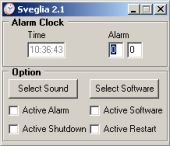 Sveglia is a simple alarm clock utility that can also be used to shut down or restart your computer at a certain time. In addition to this it can also be set to run a program at a chosen time. Sveglia is a simple alarm clock utility that can also be used to shut down or restart your computer at a certain time. In addition to this it can also be set to run a program at a chosen time.
You can select the alarm clock sound when used as a regular alarm, this can be any mp3, wav, midi, or wma sound file. So basically this is a potentially useful 3 in 1 tool ( regular alarm, automatic shutdown,rebooting, or automatic scheduled program runner).
You can try it out by going here and if you like it, keep it, it’s free!
Posted in Freeware, Main, Programming, Shell and Desktop, Utilities, Windows | No Comments »
Monday, March 19th, 2007
 Lookaway is a small program designed to remind you to not stare at your computer screen too long. Lookaway is a small program designed to remind you to not stare at your computer screen too long.
Looking at a monitor for too long can cause eyestrain, which is obviously a bad thing.
But as we all know by now, it’s easy to become so engrossed in the computer that you forget to take breaks and this is definitely not very good for your eyes.
This free program reminds you to take regular breaks,every few minutes, to literally “look away” from the screen, as even a few seconds of focusing on something else can help prevent eyestrain.
Its free and your eyes will thank you, you can get it here. ( Click “Publicity”, then “My software”).
Posted in Developer, Freeware, Main, Shell and Desktop, Utilities, Windows | No Comments »
Monday, March 19th, 2007
 This is a flash card program for helping you to learn stuff. Although the most obvious use for jMemorize is learning foreign words and expressions, you can use it for a variety of other tasks which require memorization. This is a flash card program for helping you to learn stuff. Although the most obvious use for jMemorize is learning foreign words and expressions, you can use it for a variety of other tasks which require memorization.
Card decks are the key part of jMemorize. At the beginning, all the cards are placed in what’s called the Start Deck.
During a learning session, you answer the question on each card. If you answered correctly, the card is moved to the next higher deck. A wrong answer keeps the card in the Start Deck. Based on your success rate during multiple learning sessions, it places the cards in different decks according to your success rate in answering the question. The cards in every deck have an expiration time, at which time jMemorize reactivates the already learned cards so that you can refresh your knowledge.
It’s written in Java, so it will run on most systems and browsers. You can download it here and its open source, so it’s free!
Posted in Developer, Freeware, Information Management, Java, Main, Open Source, Social Software, Windows | 1 Comment »
Monday, March 19th, 2007
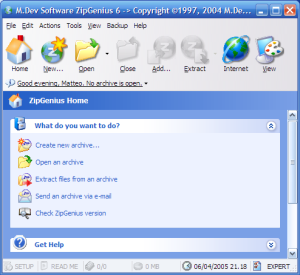 ZipGenius is a decent zip utility that offers support for more than 20 different compression formats, including 7zip, ZIP64, UPX and many more. ZipGenius is a decent zip utility that offers support for more than 20 different compression formats, including 7zip, ZIP64, UPX and many more.
It supports drag and drop, 5 compression levels, and customization and integration in Windows Explorer. It also comes with its own built in FTP client that allows to download and upload files from within it. The signature feature means you can add your signature and contact information to any zip file you create.
It also supports the creation of self-extracting exe files with custom setup launch and icon. It also comes with additional features like encryption, scanner support (acquire pictures and zip them into files), backup, statistics, download time calculator, disk spanning, file export, support for OpenOffice and more. It can also interact with your Pocket PC device.
Not bad at all, considering it’s totally freeware! You can get it here.
Posted in Backup, Developer, Freeware, Main, Open Source, Utilities, Windows | No Comments »
Friday, March 16th, 2007
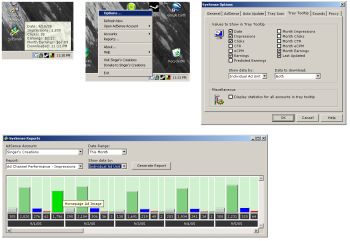 If you are one of those making money off Google’s Adsense program then this software will definitely be useful for you. It’s called SysSense. If you are one of those making money off Google’s Adsense program then this software will definitely be useful for you. It’s called SysSense.
What does it do?
SysSense is your personal desktop Google AdSense monitor. It gives you easy access as it keeps your current Google AdSense information in the Windows system tray.
What do you do?
Simply mouse over the system tray icon to view all of your current Google AdSense data. Easily log into your Google AdSense account from the SysSense system tray icon menu.
The latest Change in the latest version, SysSense 1.3.1 which was released just recently is this:
- FIXED: Made the necessary changes to fix a bug that was introduced by Google’s latest Adsense data changes
Want to check it out? CLICK HERE! (Did I fail to mention that it’s free? Sorry, IT’S FREEEEEE!!!!)
1107525983-1.gif
Visit http://www.singerscreations.com/AboutSysSense.asp for more info and download.
Posted in Business, Commercial, Developer, Freeware, Information Management, Main, Open Source, Social Software, Utilities, Web services | 1 Comment »
|
|
|
 RocketDock is a Mac-inspired dock for Windows users. For those that don’t know, a dock is fancy toolbar with some effects and added functionality thrown in and is a standard feature on Mac computers. It comes from the same people who made UberIcon, which i recently reviewed and if you also use that, Rocketdock also includes a function to use the same effects as you have chosen in UberIcon.
RocketDock is a Mac-inspired dock for Windows users. For those that don’t know, a dock is fancy toolbar with some effects and added functionality thrown in and is a standard feature on Mac computers. It comes from the same people who made UberIcon, which i recently reviewed and if you also use that, Rocketdock also includes a function to use the same effects as you have chosen in UberIcon.
 This is a cool little program that adds cool effects when you click on icons in your PC such as folder or program icons.
This is a cool little program that adds cool effects when you click on icons in your PC such as folder or program icons. Face it, who really reads the EULA’s ( End User License Agreement) in software they install? Most of us just scroll ahead and click “Accept”. But it’s something we all should do because if we don’t, we can eventually wind up with all kinds of spyware on our computers that could lead to serious problems.This program analyses the EULA and picks out suspicious text in it, letting you know if there’s anything you don’t want to agree to, such as installing adware or transmitting personally identifiable information etc.
Face it, who really reads the EULA’s ( End User License Agreement) in software they install? Most of us just scroll ahead and click “Accept”. But it’s something we all should do because if we don’t, we can eventually wind up with all kinds of spyware on our computers that could lead to serious problems.This program analyses the EULA and picks out suspicious text in it, letting you know if there’s anything you don’t want to agree to, such as installing adware or transmitting personally identifiable information etc. Here is a freeware that can help you get your digital audio tracks recorded quite easily.
Here is a freeware that can help you get your digital audio tracks recorded quite easily.
 Sveglia is a simple alarm clock utility that can also be used to shut down or restart your computer at a certain time. In addition to this it can also be set to run a program at a chosen time.
Sveglia is a simple alarm clock utility that can also be used to shut down or restart your computer at a certain time. In addition to this it can also be set to run a program at a chosen time. Lookaway is a small program designed to remind you to not stare at your computer screen too long.
Lookaway is a small program designed to remind you to not stare at your computer screen too long. This is a flash card program for helping you to learn stuff. Although the most obvious use for jMemorize is learning foreign words and expressions, you can use it for a variety of other tasks which require memorization.
This is a flash card program for helping you to learn stuff. Although the most obvious use for jMemorize is learning foreign words and expressions, you can use it for a variety of other tasks which require memorization. ZipGenius is a decent zip utility that offers support for more than 20 different compression formats, including 7zip, ZIP64, UPX and many more.
ZipGenius is a decent zip utility that offers support for more than 20 different compression formats, including 7zip, ZIP64, UPX and many more.
